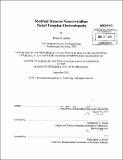Residual stress in nanocrystalline nickel tungsten electrodeposits
Author(s)
Ziebell, Tiffany D. (Tiffany Dawn)
DownloadFull printable version (4.665Mb)
Other Contributors
Massachusetts Institute of Technology. Dept. of Materials Science and Engineering.
Advisor
Christopher A. Schuh.
Terms of use
Metadata
Show full item recordAbstract
Characterizing the residual stress of thick nanocrystalline electrodeposits poses several unique challenges due to their fine grain structure, thickness distribution, and matte surface. We employ a three-dimensional profilometry-based approach that addresses each of these complicating factors and enables quantitative analysis of residual stress with reasonable accuracy. The specific emphasis of this work is thick (10-100 [mu]m), nanocrystalline Ni-W electrodeposits, in which residual stresses arise during the deposition process as well as during post-deposition annealing. The present measurements (for grain sizes ranging from 4-63 nm) offer quantitative insight into the mechanisms of stress development and evolution in these alloys, suggesting that the grain boundary structure is out of equilibrium (unrelaxed) and contains excess free volume, in and of itself acting as the primary source of residual stress in these coatings. We show that the amount of free volume initially created in the films can be predicted from the pulse amplitude of the current waveform employed during the deposition process while the corresponding grain size dictates the volume fraction of grain boundary area where this free volume can be accommodated - together, these processing and structure-based parameters control the resulting stress level in the film.
Description
Thesis (S.M.)--Massachusetts Institute of Technology, Dept. of Materials Science and Engineering, 2011. Cataloged from PDF version of thesis. Includes bibliographical references (p. 45-47).
Date issued
2011Department
Massachusetts Institute of Technology. Department of Materials Science and EngineeringPublisher
Massachusetts Institute of Technology
Keywords
Materials Science and Engineering.